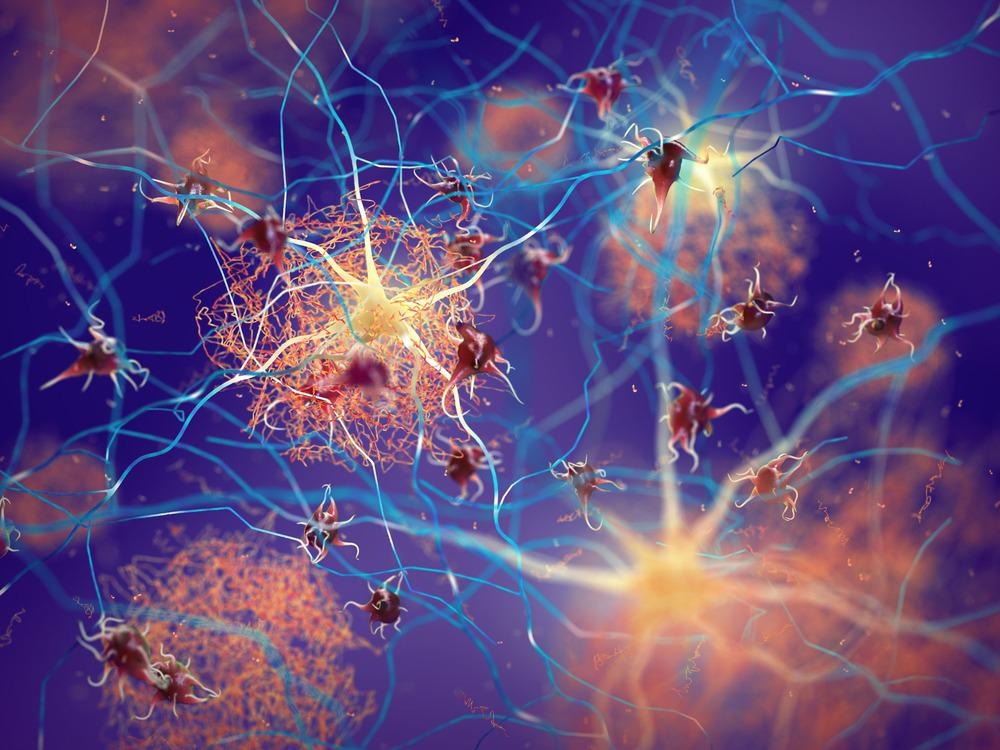In a study published recently in the journal ACS Applied Materials & Interfaces, self-luminescent solitary tryptophan nanoparticles (TNPs) were produced as a nanoscale theranostic solution for Alzheimer's disease (AD).

Study: Self-Fluorescent Lone Tryptophan Nanoparticles as Theranostic Agents Against Alzheimer’s Disease. Image Credit: nobeastsofierce/Shutterstock.com
The Pressing Need for Effective Therapy of Alzheimer’s Disease
Alzheimer's disease (AD) is a fatal neurological ailment that impairs patients' recollection, learning, and cognitive behavior. Those with Alzheimer's disease exhibit a variety of behavioral difficulties, like depression, restlessness, and anxiety.
Clinical features of Alzheimer's disease include amyloid β-42 peptide-based neuritic plaques, neurofibrillary tangles (NFTs), and loss of neurons and synapses. The Aβ-42 peptide is created by the successive proteolysis of amyloid precursory proteins (APP).
The Aβ-42 peptide is initially stored in neurons before being discharged into the neuropil formed by neuritic plaques.
The intraneural accumulation of Aβ-42 peptides might be a clinically important step in the onset of neurodegeneration in Alzheimer's disease. As a result, the formation of such intraneural neuritic plaques is a plausible focus for effective AD treatment and diagnostics.
Several anti-Alzheimer's medications are now being researched; however, these treatments have not had much impact due to their failure to cross the blood-brain barrier (BBB).
Tackling the Disease on the Nanoscale
The use of tetrahedral DNA nanoparticles (TDNs), a 3D nucleic acid framework (tFNA), has arisen as a viable therapy method for neurological illnesses.
Interestingly, TDNs may partly cross the BBB and reduce cell death in cell-based as well as animal-based models of Alzheimer's disease. Furthermore, due to their capacity to cross the BBB, carbonaceous nanomaterials, particularly carbon dots, have surfaced as attractive therapeutic nanoscale carrier platforms for treating a variety of CNS illnesses.
It has been discovered that the aromaticity, chirality, and wettability of carbon dots all had a contribution to the suppression of amyloid proteins.
Recent Advancements in Nano-Theranostics
Several new advances in nano-medications have resulted in the creation of nanoscale theranostics, a unique technique that combines diagnosis and treatment actions in a single device.
Presently, several multipurpose nanomaterials are frequently exploited as nano-theranostics because their intrinsic theranostic capabilities may function as real-time, fast, and responsive systems for successful AD diagnosis and treatment.
Tryptophan may be the Key
Changes in nutritive tryptophan (TrP) levels are often used as a nonsurgical technique to manipulate systemic TrP levels and, eventually, central serotonergic (5-HT) systems neural activity.
Variations in alimentary TrP quantities have been shown to alter the concentration of baseline extracellular 5-HT in several brain areas; decreased TrP ingestion eventually affects memory and learning. Furthermore, research shows that lowering TrP consumption affects cognitive performance in Alzheimer's patients.
Remarkably, orally administered TrP treatment has been demonstrated to improve 5-HT neural activity as well as behavioral disorders in mice. Regular 5-hydroxytryptophan (5-HTP) shots enhanced spatial memory in older rat models.
Key Developments of the Study
This research focuses on the creation of multifunctional and single tryptophan NPs as a tool for the concurrent imaging, detection, and treatment of Alzheimer's disease.
The luminescent nanoparticles produced in this work were able to split dipeptide FF fibrils in a time-dependent way. The anti-amyloidogenic action of self-luminescent TrP NPs was investigated using FF as an amyloid reductive system. Furthermore, test-tube experiments using Aβ42 peptide demonstrated that the NPs effectively inhibited the accumulation of preexisting Aβ42 peptide clusters.
Surprisingly, dipeptide fibrils alone had lethal effects in neural cells; however, whenever the cells were treated with TrP NPs, the extent of apoptosis was considerably decreased. Due to their auto-fluorescence, the developed TrP NPs have the prospects to be used as bio-imagery agents. Furthermore, the nanostructures created have shown exceptional neuroprotective benefits in reducing cognitive impairments and decreasing Aβ42 oligomer formation in the brains of ICV-STZ-induced AD rats.
A pharmacokinetic investigation of the nanoparticles revealed that they may penetrate the blood-brain barrier to obtain entry to neural tissues and subsequently act as a cerebral delivery mechanism.
Ultimately, the cyto-compatible, completely straightforward, and luminescent TrP NPs created here may prove to be effective nano-theranostic tools for the treatment and detection of Alzheimer's disease.
Reference
Sharma, M., Tiwari, V., Chaturvedi, S., Wahajuddin, M., Shukla, S., & Panda, J. J. (2022). Self-Fluorescent Lone Tryptophan Nanoparticles as Theranostic Agents Against Alzheimer’s Disease. ACS Applied Materials & Interfaces. Available at: https://pubs.acs.org/doi/10.1021/acsami.2c01090
Disclaimer: The views expressed here are those of the author expressed in their private capacity and do not necessarily represent the views of AZoM.com Limited T/A AZoNetwork the owner and operator of this website. This disclaimer forms part of the Terms and conditions of use of this website.